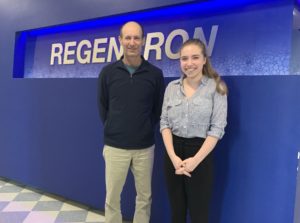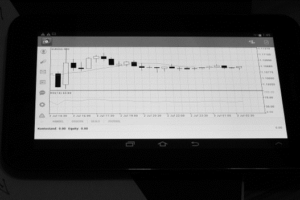Thanks to the generous support of Regeneron, each quarter, a local high school student with a passion for science will be paired with a Regeneron scientist so they can learn what it’s like to put STEM education to work in the real world. The River Journal would like to thank Regeneron for opening their doors – and labs – to future scientists from the River Towns.
 The opportunity to spend time at one of the most innovative biotechnology companies was incredibly exciting to me, and my visit absolutely matched my high expectations. It was initially surprising that such a growing company had its headquarters situated just a few miles away from my small hometown, but getting the chance to speak with Dr. Gavin Thurston lent insight to how research is conducted at Regeneron.
The opportunity to spend time at one of the most innovative biotechnology companies was incredibly exciting to me, and my visit absolutely matched my high expectations. It was initially surprising that such a growing company had its headquarters situated just a few miles away from my small hometown, but getting the chance to speak with Dr. Gavin Thurston lent insight to how research is conducted at Regeneron.
After finding the right conference room (there are so many!), sitting down with Dr. Thurston clarified many aspects of the research process, both at Regeneron specifically and in general. Dr. Thurston, an oncology researcher, gave me an overview of how Regeneron makes a class of drugs that are essentially “elegant versions of human antibodies” designed to bind and fight cancer cells. This method of cancer treatment may be able to be used across different cancers–skin, lung, and cervical cancers, to name a few. Currently there are six different investigational medicines tested in clinical trials, in which Thurston’s team members are using sophisticated measures to track the reactions of antibodies, immune cells, and tumor cells.
A scientist at Regeneron for 19 years, Thurston first experimented at the lab bench but is now a manager to many projects. His experience in both roles offered me a lot of understanding to how, on a macro-level, research goes from start to finish. To plan projects and push them along, Thurston describes his process as asking fundamental questions like, “What’s the most important thing to do?” and “How can we get it done using the resources (disease models, technologies, etc.) available?” Despite these important questions, Dr. Thurston asserted that there is no one “right” way for a project to get started; it can be either Dr. Thurston’s boss who gives a recommendation or a junior member on his team with a new discovery that ends up becoming a topic of research. Since Regeneron is a biotech company invested in using technology produced in-house, there’s a unique focus on figuring out how to apply technological resources to biological research.
Dr. Thurston, of course, is not alone in this effort: research is an inherently collaborative process and he gave credit to his team members who, with their “diversity in expertise,” contribute new perspectives. The unifying element across the board, though, is what Thurston describes as the “scientific culture” at Regeneron. This same culture is what inspires researchers who are possibly frustrated with a setback in their plan to enjoy the research process itself and not just the outcome – and in turn learn from any of these sorts of setbacks.
As I hope to eventually work in a research field, I’m consistently curious about the steps scientists take to begin their path and how they view the future of research. Thurston self-identified as a STEM student, like many of us high school students in science research programs. The interdisciplinary nature of his biophysics program at graduate school drew him in to biological subject of his current research. When prompted about what he believes will be the focus of future cancer-related research, Dr. Thurston highlighted the era of immunology and autoimmune diseases. However, he qualified his suggestion with the fact that there are so many areas of prevalent research. This itself emphasizes the importance of exposing the new generation of budding scientists to the endless possibilities of STEM careers–something that Regeneron is actively doing and that I was very lucky to have experienced.
Zoe London is a senior at Briarcliff High School. She’s a member of the National Honor Society and took 1st Place in the Westlake Science Research Fair for Behavioral Studies in 2018. Zoe is Co-Editor-in-Chief and Staff Editor of The Bulletin, Briarcliff High School’s school paper. She is also a competitive dancer and has won numerous awards for dancing.








This is a wonderfully written article especially for a high school senior it was really remarkable